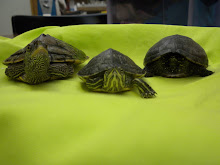Hannah's Winter is comprised of layers of contradictions that work together in the end to make up a surprising and delightful book.
I first picked this one up to read because I was intrigued by a contradiction in style right on the back cover. In the excerpt printed there you first read, "snow was tumbling soft from the sky, gentle as flower petals." Then in the next paragraph we have, "She wrapped me up in layers of socks and gloves and scarves and sweaters until I looked like a neurotic sumo wrestler." The first description was quite poetic, the second was...er...not. I wondered if these two styles would be repeated throughout the book, and if so, whether the author could pull it off without sounding slightly bipolar.
The answer to both is a resounding yes. The more serene descriptions tend to be used for the surroundings, while more colorful, modern terms are used for the characters. I soon found this combination of traditional and modern to be a theme throughout the book. The characters, all 3-dimensional and likeable, encompass both worlds, as do the settings. The story itself is a combination of modern day thinking and ancient Japanese folklore. The mystery is more a part of the story, unfolding quickly and satisfyingly, than it is a brain-teasing-whodunit.
The only contradiction I did not enjoy was the disparity in descriptions of life in Japan vs. the main character's background information. The first part of the book begins to feel like a travel guide, trying to cram in as many Japanese words and cultural tidbits as possible. As intriguing as I found things like the water shooting out of the ground to melt the snow, I really wasn't interested in a continual vocabulary lesson.
Fortunately, the story line and characters quickly took over, and I'm willing to say that first bit added to the newness of being in a strange country. But then that leads to the disparity. Why was she here? Why did her mother insist on her coming? She mentions the educational aspect, the lack of supervision at home, but then why didn't her brother come, too? Why is she fluent in Japanese, anyway? Yes, she lived there briefly as a small child, and then studied Japanese for two years in school - but, why? According to my Australian friend, a long-neck turtle living in a 4th year classroom, while Japanese is often a foreign ,anguage choice, it isn't usually offered until the 8th year. Why is it so important to her mother that she is fluent? And is a childhood memory plus a couple years in school really enough to understand a language when it is spoken in its native country, with seemingly no translation problems? A little too convenient to be entirely plausible, which is disappointing considering how well everything else in the story is fleshed out.
In spite of the above, I thoroughly enjoyed the story. It may not have escaped your notice that I didn't actually tell you what the story is about - and I'm not going to. There is no way I could give any more of the plot than is on the jacket cover without making it sound ridiculously implausible, something Meehan has managed not to do. Suffice it to say that this one should appeal to a variety of ages, to girls and to more mature boys, and to both fantasy lovers and those who prefer realism. A must-have for school and public libraries.
And now I have a strange craving for donuts...
Want to learn more about Japanese language and culture? This site can give you a start:
http://www.freejapaneselessons.com/
The Snowman Code, by Simon Stephenson
-
A snowy day in front of a cozy fire provided perfect reading conditions
for The Snowman Code, by Simon Stephenson (December 16, 2025, Simon and
Schuster...
2 weeks ago


Oh no! Another must have for my TBR. Thanks for the awesome review.
ReplyDelete